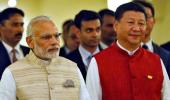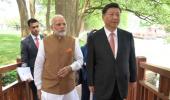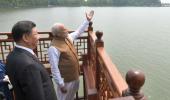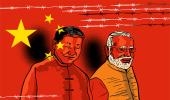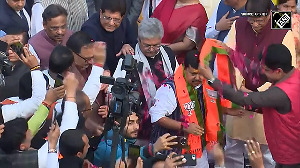'This novel format of diplomacy -- the informal summit -- will not only facilitate bilateral communication and reduce miscalculations at the very top level of the two governments, but possibly open the space for China and India to speak in one voice on various issues of mutual concern,' note Feng Renjie and Ding Kun Lei.

Following the momentum initiated at the Modi-Xi Wuhan Summit, Mamallapuram, an ancient Pallava era coastal town located in Tamil Nadu, will witness the second edition of the India-China informal summit, which is scheduled for October 11.
The two leaders will discuss a wide range of issues, including issues in their bilateral relations and beyond.
This format of communication offers the two leaders a smooth and fruitful channel for enhancing mutual understanding, avoiding strategic miscalculations and forging cooperation in multiple areas.
The idea of holding an informal summit, floated during the 2017 Shanghai Cooperation Organisation summit in Astana, is believed to be an effective way to discuss issues of utmost concerns between two top leaders as well as to enhance implementations of those signed agreements in various formal summits.
'Top-Down Pushing' and 'Action-Oriented' are the most significant characteristics of the summit and both sides have witnessed positive outcomes on five aspects since Wuhan.
First, strategic communications were further enhanced through the mutual visits of high-level officials including Defence Minister Rajnath Singh, China's State Councilor and Foreign Minister Wang Yi etc.
Second, China has increased imports of rice and medicines from India, which, to a limited extent, contributes to reducing the trade deficit.
Third, both sides have carried out the 'India-China plus' approach to jointly provide training to Afghan diplomats.
Fourth, the people-to-people connection has been further tightened through the establishment of 'High Level Mechanism on Cultural and People-to-People Exchanges'.
Last but not the least, through candid, face-to-face exchange of views through this informal interaction, Modi and Xi have reached the consensus that it is in neither side's interest to let border tensions escalate and go out of control.
The two leaders have emphasised the importance of maintaining the tranquillity of borders.
Recognising the success of the Wuhan informal summit last year, this year's informal meeting will not only continue the momentum of deepening cooperation between two giant countries to maintain border tranquillity, but is also of great importance and necessity to head off trade protectionism, terrorism, economic slowdown, etc.
For long, bilateral relations have been facing the challenge of a trust deficit, not only primarily due to unresolved border disputes, but also due to a broad spectrum of dissensions, ranging from political and security issues (India's bid for the a permanent seat on the United Nations security council, membership of the Nuclear Suppliers Group, China's increasing presence in the Indian Ocean, etc) at one end, to economic issues (CPEC, BRI, trade deficits, barriers of access to each other's market, etc) at the other.
Scholars, think-tank analysts, and officials have gone to great lengths to discuss a profusion of rifts between India and China.
The discussion here has no intention to revisit these dissensus.
Instead, it attempts to identify the scope of synergy where the interests of the neighbouring giants could be aligned with each other.
India and China reached a consensus in 1993 during then prime minister Rajiv Gandhi's visit to China that resolving border issues would not be a precondition to normalise bilateral relations.
In a similar spirit, although it is recognised that the disagreements are formidable, sorting out those rifts shall not be the prerequisite for exploring the potential and concretising cooperation on the ground.
Enhancing bilateral ties through the signals sent out at the informal summit could bring considerable benefits for the well-being of people in both countries.
The following issues could be the three major areas to harness the opportunities of synergising the interests of India and China:
5G Technology: New Area of Cooperation?
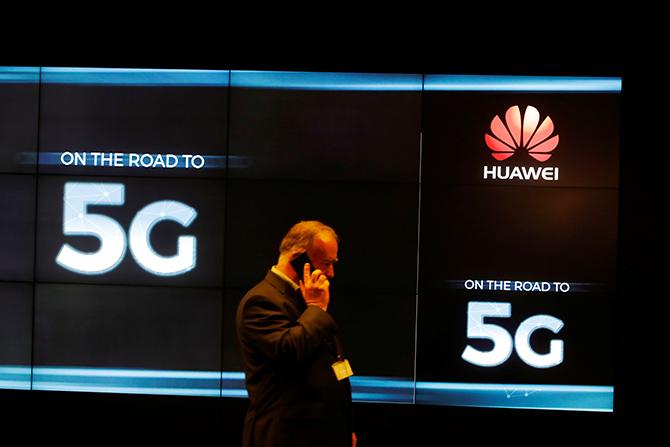
First of all, compared with the previous agenda in Wuhan last year, 5G could be a novel topic at the Mamallapuram summit since it is too significant to be bypassed.
Exploring the potential to work together on this next-generation technology would attain a win-win situation for India and China due to several reasons.
From India's side, the most obvious reason to consider cooperation with Huawei is its cost-effective advantage.
Huawei's 5G technology is relatively inexpensive, but also technologically advanced.
Introducing 5G technology in India could adequately inform India's Smart City and Digital India initiatives.
This revolutionary cellular network will upgrade the hardware into an intelligent level in areas including transportations, healthcare, electricity grids as well as other infrastructure.
More importantly, it will substantially impart modern facilities like remote medical surgery and high-quality education to Indian rural areas.
Additionally, India has been successfully resisting external pressure to maintain its geopolitical autonomy on various issues since its Independence.
India's decision on 5G will be based on her own judgment of whether working with China could substantially benefit the Indian people and in line with its national interests, instead of succumbing to external pressures, for example, from the United States.
As for China's concern, cooperation on 5G between two countries will serve China's commercial interest at the backdrop of the US's tireless campaign to persuade its allies to exclude Huawei from their domestic markets and to ban US companies from doing business with this Chinese telecom giant.
However, overlap of interest in 5G between India and China do not necessarily lead to cooperation.
But when we take into account two shades of India's concerns, we will realise that those will not hamper, but facilitate both countries to cross the barriers and march towards further meaningful collaboration.
First, for Modi's administration, 5G is not only a commercial question but primarily a security and political call.
Hence, China and India should engage with each other to address India's concern of 'backdoor worry'.
India is not yet entirely convinced about the offer -- 'no-backdoor' pack -- mentioned by the firm, in June to assuage potential security concerns.
Indian scholars and journalists have advocated that India should negotiate with China on a joint adventure on the 5G through purchasing the licenses from Huawei, especially after Ren Zhenfei came up with an offer to sell a license to a Western company.
It is not sure which direction the cooperation between India and China will go, but it has demonstrated the enthusiasm of exploring the potential of working together on this domain.
Three examples, informed from media reports, have demonstrated that different levels of officials are dedicated to enhancing communications and consultations.
First, Vikram Misri, India's ambassador to China, exchanged views with his counterparts at the Chinese foreign ministry in Beijing on July 10.
Second, Hua Chunying, the spokesperson, engaged with the media on this topic on August 6.
Last but not the least, Sun Weidong, the Chinese ambassador to India, has signaled that 'China believes India will take a fair, independent decision' on Huawei in an interaction with The Times of India on September 25.

Trade Deficit: Core Concern in Bilateral Economic Relations
Secondly, bilateral investment and trade will undoubtedly occupy the central part of the agenda this time.
India has a trade deficit of $53 billion with China.
How to address the trade imbalance will be a key concern for the two leaders, especially for Prime Minister Modi.
Great effort has been dedicated to bringing the deficit down by India and China.
The India-China joint group on economic relations has held meetings periodically to discuss trade-related issues.
Till March 2018, 11 rounds of negotiations have been held to discuss matters relating to obtaining market access to Indian agriculture, dairy, pharmaceutical products, etc.
Meanwhile, various protocols have already been signed to facilitate exports of rice, tobacco fishmeal, etc from India to China.
In the last few years, Chinese buyers-Indian sellers meetings have been organised by India's ministry of commerce and industry and its Chinese counterpart. Indian exporters have been invited several times to showcase their products in major trade fairs in China.
Dr S Jaishanker, India's foreign minister, exchanged views on facilitating Indian exports to China with Wang Yi, his counterpart, at the second meeting of the India-China High Level Mechanism on Cultural and People-to-People Exchange in August.
Among all the products that India yearns to export, pharmaceutical products and IT-related products and services are two goods that India has vigorously sought access to the Chinese market.
This year has witnessed some positive changes.
China's legislation revised the drug law to remove those drugs that are legal in foreign countries but not approved in China from the category of fake medicines, which may facilitate opening the door for Indian generic medicines into the Chinese market.
What is more? A workshop in Shanghai was jointly conducted on June 21, 2019 by the national medical products administration of China, and the central drugs standard control organisation in India, aiming to train Indian pharma exporters on updated regulatory practices in China.
This law will take effect on December 1, which could be seen as the first step to remove certain barriers of importing Indian medicines to China.
Further closer trade relations on pharmaceutical products would lead to win-win results for both India and China.
However, we have to admit there is still a long way to go.
Although the shrinking of trade deficit amounts to $10 billion in the fiscal year ended till March 2019 to $53 billion, several Indian financial analysts remain sceptical of reducing the trade deficit, arguing that China has already begun to ship some of its products through Hong Kong rather than its domestic ports.
Hence, the calculation of the Indian trade deficit with China should combine the mainland with Hong Kong.
It is foreseeable that, at the backdrop of various global uncertainties, the heads of India and China will carve out an overall framework of economic cooperation at the Mamallapuram summit, which would guide the practices and implementations taken by the relevant ministries of both sides.
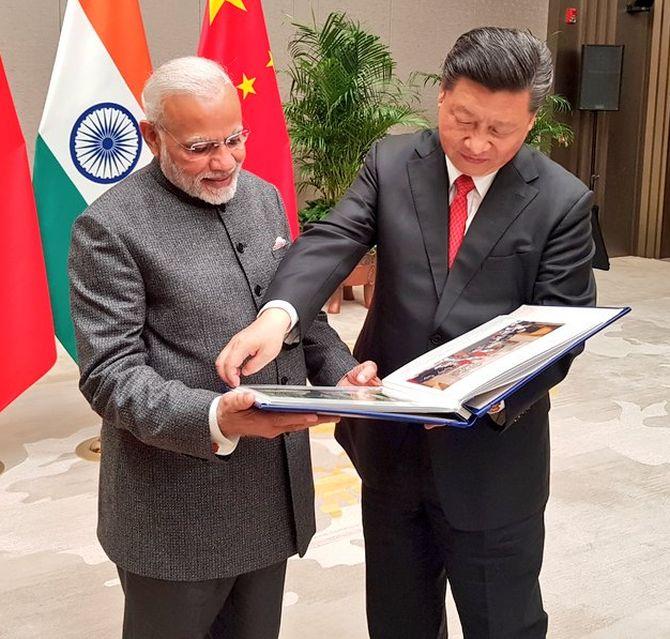
China India Plus: Cooperation beyond Bilateral Relations
The heads of the two governments at the Wuhan Summit in April 2018 had reached the agreement that India and China would coordinate to engage a third country or set of countries in South Asia and beyond.
This consensus has paved the way for the two countries' coordination in bringing peace and development to Afghanistan.
Joining hands to train Afghan diplomats in October 2018 acted as a concrete step to translate the concept 'China-India plus' into action.
It would be meaningful for Modi and Xi to discuss expanding the model of 'India-China plus' from South Asia to Africa.
Diplomats of both countries have signalled that both Asian giants are on the same page in their efforts to assist African countries.
On the way to attend the BRICS summit in South Africa, Modi and Xi visited Rwanda within 24 hours.
To a great extent, India and China have complementary advantages in contributing to the prosperity and development of Africa.
On the one hand, India has historical linkages, cultural ties, and a large Diaspora in East Africa, which renders India with better non-governmental relation with African countries.
India has successfully facilitated the development of human capacity in Africa by providing free medical consultancy and training to doctors, nurses, and soldiers, etc through e-network projects such as e-Vidhya Bharati and e-Arogya Bharati.
On the other hand, China has provided hefty financial aid and conducted large-scale infrastructure building, including roads, power plants, and railways, etc.
Through the framework of South-South Cooperation, the Mamallapuram Summit could explore the undiscovered potentials and push the joint efforts of two sides to further advance the empowering of African countries.
Apart from the implementation of a 'China-India plus' approach, it will be encouraging if Modi and Xi could exchange views on joining hands in shaping the emerging global order and increasing the voices of developing countries in the international regimes.
Working together with other developing countries, India and China have successfully pressurised the IMF and World Bank to increase the voting shares and quotas of emerging economies, which served as an overdue step to increase the representations of developing countries.
Furthermore, both countries played a significant role in establishing the New Development Bank and Asian Infrastructure Investment Bank, which has been perceived as positive changes to break the monopoly of Bretton Woods institutions.
Meanwhile, in the climate change negotiations, India and China have been working closely for more than two-and-a-half decades in the blocs of G77+China, BASIC, and Liked-Minded Developing Countries to fight for climate justice and equity.
Through the interactions of Prime Minister Modi and President Xi in October, both countries could enhance their collaboration to shape the international order and the model of global governance in the direction that favors the interests of emerging powers.
The ambience of the informal summit is full of complexity.
In the background is Modi's eye-catching visit to the US, the ongoing US-China trade war and Pakistan Prime Minister Imran Khan's high-profile visit to China this week.
We have also seen Chinese and Indian soldiers raise a toast to friendship on October 1 days after a scuffle broke out between soldiers of both sides on the bank of the Pangong Tso lake in September.
In the foreseeable future, bilateral relations, characterised by uncertainty and fluctuations, will continue, but this novel format of diplomacy -- the informal summit -- will not only facilitate bilateral communication and reduce miscalculations at the very top level of the two governments, but possibly open the space for China and India to speak in one voice on various issues of mutual concern beyond bilateral relations and contribute to peace and prosperity around the world at large.
Feng Renjie is a doctoral candidate, Centre for International Politics and Disarmament, School of International Studies, JNU, New Delhi. Ding Kun Lei is a PhD candidate at Tsinghua University, Beijing.
